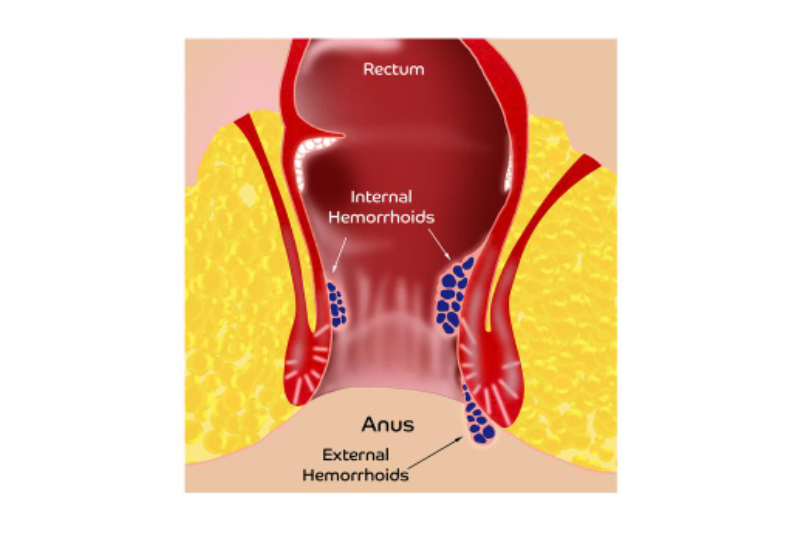Difference Between Internal, External Hemorrhoids and Anal Skin Tags
Hemorrhoids and anal skin tags form a lump around the anus. Their similar appearance can make it daunting for patients and non-specialist doctors to differentiate. Understanding this, we have covered a detailed analysis of internal and external hemorrhoids and anal skin tags in this guide. It features comprehensive details, including symptoms, causes, treatments, and surgical and non-surgical treatments. Surely be able to differentiate between these conditions.
Internal Hemorrhoids
Internal hemorrhoids are located inside the rectum. Pushing hard during a bowel movement and straining to lift heavy objects. Mainly cause these issues. However, other causes include pelvic pressure from weight gain and constipation. Internal hemorrhoids normally go off by themselves. They don’t cause any life-threatening situations, and most cases are even painless. Because the rectum doesn’t have any nerve to detect pain. Furthermore, it’s even possible for patients to never experience symptoms of internal hemorrhoids.
In rare cases, internal hemorrhoids might develop into serious and painful conditions. If so, individuals may experience harsh symptoms. For instance pain and discomfort, bleeding, itching, burning, lumps, or swelling around the anus. Mostly, bowl movements irritate internal hemorrhoids, showing bright blood on toilet paper. Consult with the doctor if experiencing rectal bleeding or the symptoms don’t go away.
Surgical and Non-Surgical Treatments
Internal hemorrhoids don’t need any surgical treatments. Individuals can treat these conditions with certain lifestyle changes, non-surgical treatments, and medications. Some suggested treatments include:
High-Fiber Foods
Include fiber in your diet to soften your stool, which will prevent rectal bleeding. Slowly add fiber to your meals to avoid gas problems.
Pain Relievers
When feeling pain, you can take pain relievers. Ibuprofen, acetaminophen, aspirin, or any medication will work to relieve your discomfort.
Warm Bath
Soak the anal area for around ten to fifteen minutes in plain water every day. A sitz bath fits over the toilet.
Topical Treatments
Apply a suppository featuring hydrocortisone or hemorrhoid cream, which you can buy without a prescription. You may also use pads with numbing cream or witch hazel.

External Hemorrhoids
External hemorrhoids occur under the skin in the region surrounding the anus. The bumping of tenders causes these issues. Dilated blood vessels enlarge enough to protrude. Occasionally, blood may clot inside the blood vessel, creating a painful lump. Some main causes include pregnancy, obesity, sitting on the toilet for too long, and not getting enough fiber. Heavy lifting and straining while pooping are also common causes.
Symptoms of external hemorrhoids are diverse. These vary depending on the severity of the situation. Some common symptoms are itching around the rectal area and anus. As well as tender, blue-colored lumps on the skin around the anus, and pain or aching around the anus. You may also observe bleeding on the toilet. Large external hemorrhoids can make it difficult to keep the anal region clean.
Surgical and Non-Surgical Treatments
External hemorrhoids don’t need any surgical treatment unless you experience severe pain. Homemade remedies include sitz baths, cold compress, OTC creams, topical ointments, and wipes. In severe cases, doctors might suggest surgical procedures. This includes the removal of an external hemorrhoid via laser, cautery device, or scalpel. Although, doctors might use a local anesthetic during the procedure. Here are some of the surgical procedures:
Hemorrhoidectomy
During this procedure, doctors remove extra tissue causing bleeding. Doctors often perform surgery with an anesthetic combined with medications. Futher to help individuals feel relaxed and calm. Doctors might also use general or spinal anesthesia during the procedure.
Hemorrhoid Stapling
Doctors block the blood flow to hemorrhoidal tissues. It’s less painful than hemorrhoidectomy. However, the chances of recurrence of hemorrhoids’ recurrence are higher.
Coagulation
Doctors use lasers, infrared light, or heat to harden the bleeding hemorrhoid. This procedure has minimal side effects and causes less discomfort. Doctors mainly use it for internal hemorrhoids. They also find it effective for external ones.
Anal Skin Tags
Anal skin tags are a piece of excess tissue around your anal region. It doesn’t cause any pain or bleeding but might anal skin tags might feel uncomfortable and itchy. Primarily, these tags start developing as small lumps. Due to repeated trauma from cleaning or recovering from anal fissures or clotted hemorrhoids. Other common causes include intensive exercise, pregnancy, diarrhea, heavy lifting, and blood clots in the anal region.
Though these tags are benign. However, they can still cause concerns. So, it’s always a good idea to consult with the doctor. Their diagnosis includes a physical exam in which doctors analyze the appearance of anus and rectum. Anoscopy and sigmoidoscopy are other diagnosis methods.
Surgical and Non-Surgical Treatments
Treatments involve removing the excess tissues. It’s usually an in-office treatment. Doctors inject a numbing medication around the skin tag. They may give you a sedative to keep you calm during the treatment. Doctors can use multiple methods to remove the process, from mere scissors to relying on non-surgical procedures. The latter includes liquid nitrogen or laser instead of surgical excision.
Cryotherapy
Cryotherapy is a rather common treatment for skin tag removal. In it, doctors use liquid nitrogen to freeze the skin tag. Within a few days, your anal skin tag will fall off. The same is the case with laser removal, which burns the tag instead of freezing it.
What are the Key Differences?
External and internal hemorrhoids have their differences hidden in their names. One affects internally, while the other is external and can also protrude. However, anal skin tags are something different. While, anal skin tags are normally painless, and their color is the same as that of your skin. Whereas, hemorrhoids are generally painful with a red or purple color. On one hand, anal skin tags won’t usually bleed. But hemorrhoids can bleed even after light contact. Moreover, unlike external hemorrhoids, anal skin tags can’t protrude. Therefore, it isn’t that difficult to differentiate them.
One can differentiate hemorrhoids and anal skin tags mainly by their pain levels, color, and bleeding. Experiencing any of these symptoms, and triggers mentioned above. Still, ensure to consult with the doctor before taking any medication. Our doctors carefully analyze individuals’ specific cases. To better decide which one they are suffering with and recommend the best-suited minimally invasive treatment accordingly. Nonetheless, offer personalized assistance to cater to your issue, depending on its severity.



